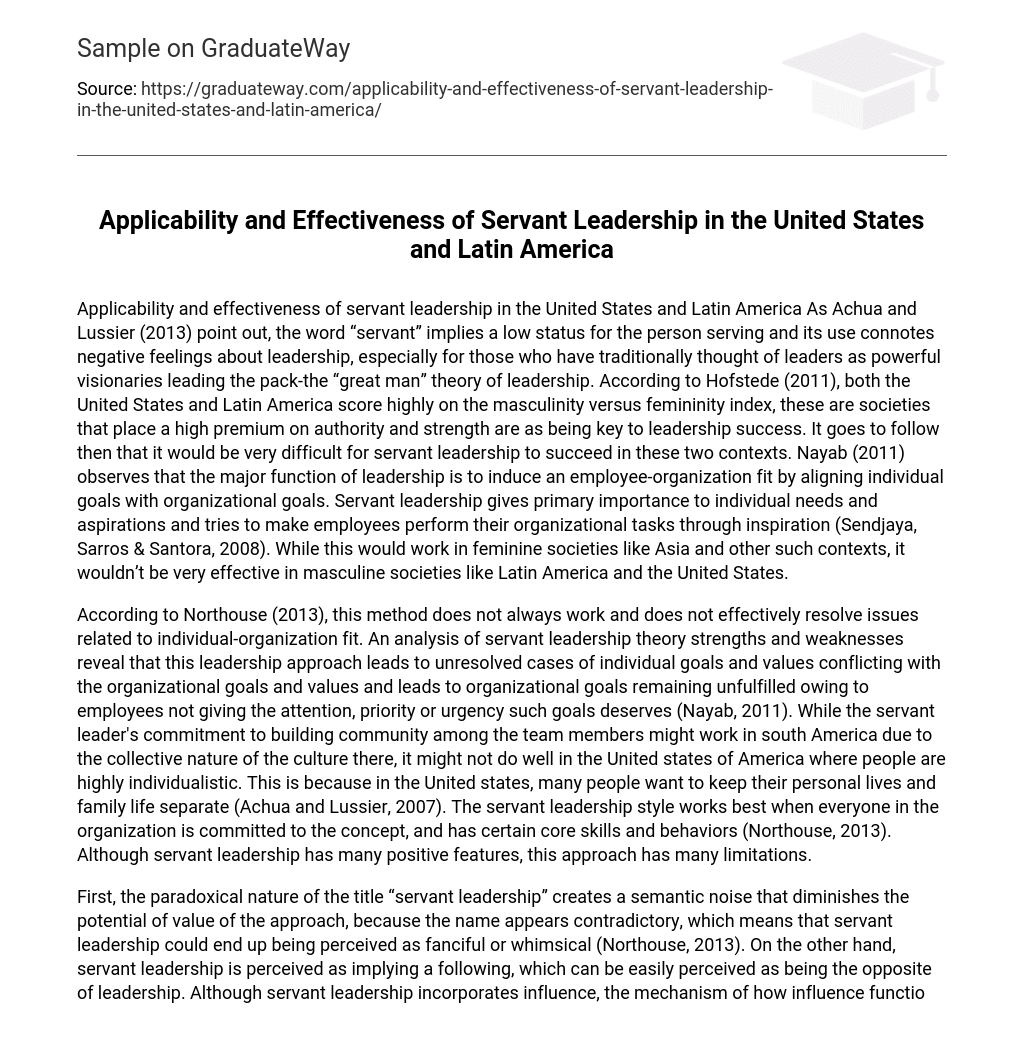Applicability and effectiveness of servant leadership in the United States and Latin America As Achua and Lussier (2013) point out, the word “servant” implies a low status for the person serving and its use connotes negative feelings about leadership, especially for those who have traditionally thought of leaders as powerful visionaries leading the pack-the “great man” theory of leadership. According to Hofstede (2011), both the United States and Latin America score highly on the masculinity versus femininity index, these are societies that place a high premium on authority and strength are as being key to leadership success. It goes to follow then that it would be very difficult for servant leadership to succeed in these two contexts. Nayab (2011) observes that the major function of leadership is to induce an employee-organization fit by aligning individual goals with organizational goals. Servant leadership gives primary importance to individual needs and aspirations and tries to make employees perform their organizational tasks through inspiration (Sendjaya, Sarros & Santora, 2008). While this would work in feminine societies like Asia and other such contexts, it wouldn’t be very effective in masculine societies like Latin America and the United States.
According to Northouse (2013), this method does not always work and does not effectively resolve issues related to individual-organization fit. An analysis of servant leadership theory strengths and weaknesses reveal that this leadership approach leads to unresolved cases of individual goals and values conflicting with the organizational goals and values and leads to organizational goals remaining unfulfilled owing to employees not giving the attention, priority or urgency such goals deserves (Nayab, 2011). While the servant leader’s commitment to building community among the team members might work in south America due to the collective nature of the culture there, it might not do well in the United states of America where people are highly individualistic. This is because in the United states, many people want to keep their personal lives and family life separate (Achua and Lussier, 2007). The servant leadership style works best when everyone in the organization is committed to the concept, and has certain core skills and behaviors (Northouse, 2013). Although servant leadership has many positive features, this approach has many limitations.
First, the paradoxical nature of the title “servant leadership” creates a semantic noise that diminishes the potential of value of the approach, because the name appears contradictory, which means that servant leadership could end up being perceived as fanciful or whimsical (Northouse, 2013). On the other hand, servant leadership is perceived as implying a following, which can be easily perceived as being the opposite of leadership. Although servant leadership incorporates influence, the mechanism of how influence functions as a part of servant leadership is not fully explicated in the approach. On the other hand, Nayab (2011) points out that a major servant leadership criticism relates to its soft approach, which is unsuitable for a competitive environment. According to Nayab (2011), the servant leader focuses on “serving” and “inspiring” followers, and this leads to a dilution of accountability and responsibility, because in most first world countries, which the united states is one, people like an authority figure, someone to give direction and a servant leadership would be very highly favored as people would feel like they lack someone to give the organization a direction.
During crisis situations, servant leaders would find themselves having to suspend the listening and consultative processes and being forced to issue specific orders (Mutia &Muthamia, 2014). Also, servant leadership thrusts on human resource development would fall flat on its face when market pressures force the organization to downsize (Sendjaya et al, 2008). According to Blanchard and Hodges (2003), there is a raging debate among servant leadership scholars regarding the core dimensions of the theory. This is because, although servant leadership is hypothesized to include a multitude of abilities, traits and behaviors, to this day researchers are unable to reach a consensus on a common definition or theoretical framework for servant leadership (Nayab, 2011).
Consequently, Northouse (2013) suggests that, until a larger body of findings is published on servant leadership, the robustness of theoretical formulations about it will remain limited. As Blanchard and Hodges (2003) observes, a large segment of the writings on servant leadership have a prescriptive overtone, that imply that good leaders “put others first”. While advocating an altruistic is commendable, it has a utopian ring because it conflicts with individual autonomy and other principles of leadership as directing, concern for production, goal setting and creating a vision (Gergen, 2006).





